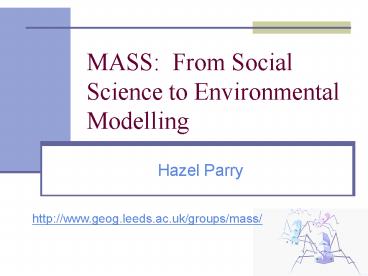MASS: From Social Science to Environmental Modelling - PowerPoint PPT Presentation
Title:
MASS: From Social Science to Environmental Modelling
Description:
Advantages and logic of using MASS in ecology ... Established modelling techniques in ecology and physical geography. Differential Equations ... – PowerPoint PPT presentation
Number of Views:22
Avg rating:3.0/5.0
Title: MASS: From Social Science to Environmental Modelling
1
MASS From Social Science to Environmental
Modelling
- Hazel Parry
http//www.geog.leeds.ac.uk/groups/mass/
2
Outline
- Background
- Connections between social and ecological
modelling - Advantages and logic of using MASS in ecology
- Multi-agent systems as a unifying methodology for
environmental modelling in geography?
3
Established modelling techniques in ecology and
physical geography
- Differential Equations
- Lotka-Volterra (predator-prey)
- Navier-Stokes equations (fluid-flow)
- Horton equation (infiltration)
4
Background The complexity paradigm
- Complexity
- Neither random nor regular, when it is hard to
formulate overall behaviour of a system, despite
individual-scale information. - Self-organization
- The process by which autonomous agents interact
in a seemingly chaotic manner, resulting in
global order. - Emergence
- Simple units, when combined, form a more complex
whole. For example, ecosystems are a synergy of
individuals. The ecosystem is greater than the
sum of its parts (Odum). - Complex systems
- Made up of agents interacting in a non-linear
fashion. The agents are capable of generating
emergent behavioural patterns, of deciding upon
rules and of relying upon local data.
5
Social vs. Economic vs. Ecological worlds
Social Sciences Economics Ecology
Society Economic Interaction Ecosystem
World of (social) interactions Game/Puzzle World of (ecological) interactions
Interdependence Interaction Interdependence/ interaction
Dependence, value Utility Dependence, utility, need
Action Strategy/ Move Action
Dependence theory Game Theory Ecosystem Theory
Interference, Influence, Exchange Strategy Competition, predation, parasitism
6
Object based models in ecology and social science
- Individual-based models
- Large collection of interacting organisms.
- Cellular Automata
- Cells on a grid of specific dimension, undergo
transition by global rules. - Multi-agent simulation
- Intelligent agents, with ability to learn about
their environment and adapt their behaviour
accordingly.
7
Cellular Automata
- discrete models of spatio-temporal dynamics
obeying local laws (Randy Gimblett, 2002, pp2) - Grid-based formed by identical cells
- Interaction of cell with its neighbours
- Time advances in steps
- State of cell determined by global rules
8
Example - diffusion
Von Neumann
t0
t1
9
Cellular Automata in ecology
Le Page and Bousquet Cellular Automata model for
the spread of forest fire
10
Cellular Automata in physical geography
Murray-Paola model of sediment transport in rivers
Baas Model of sand dune landscape formation
11
Multi-Agent Systems and Simulation (MASS)
- Similar to CA
- Less rigid structure
- Interactions between distant individuals at a
variety of scales - Facilitate investigation of lower level
mechanisms leading to global structural and
dynamical features
12
MASS a logical ecological modelling strategy
13
The advantages of a MASS approach
- Reduced randomness
- Increased flexibility
- Increased realism perception, communication,
rationality, goals, interactions, autonomy,
mobility and collaboration all possible. - Can handle complex systems
- Agents have the capacity to evolve or adapt their
behaviour. - Dont need to throw the baby out with the bath
water! - Integration of landscape models with ecological
and social models
14
A unifying methodology?
- Environmental management needs to be more
integrated and flexible. - Ecological models benefit from an integral
dynamic environmental model to produce realistic
simulations. - They also benefit from a consideration of the
social structure and dynamics where decisions
impact the entire system. - For example
- SIMDELTA
- MODULUS
15
SIMDELTA
Village
- The artificial world of SIMDELTA (Bosquet and
Cambier) - Dynamics of fish population
- Biological and topological factors affecting the
evolution of the fish - Decision making of the fishermen
16
Discussion
- Contributions of social science to agent-based
simulation in ecology. - Potential to use multi-agent simulation in other
areas of physical geography. - Multi-agent systems as a unifying methodology for
environmental modelling in geography?

